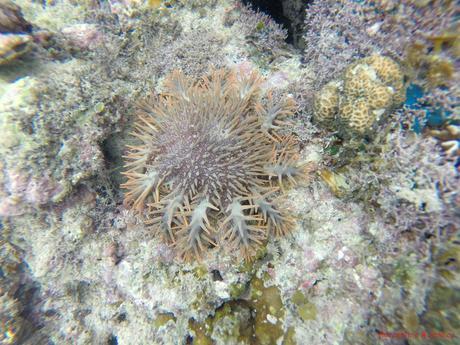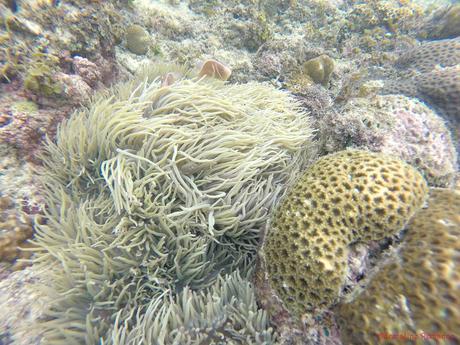
The Coral Triangle is a 5.7 million square kilometer, roughly triangular area of tropical marine waters that encompass the Solomon Islands, Papa New Guinea, Malaysia, Indonesia, and our very own Philippines. With 500 species of reef-building corals and innumerable species of marine organisms that call these corals home, the Coral Triangle is dubbed the Amazon of the sea. Its rich resources are more than enough to sustain the 120 million people.
Being part of the rich Coral Triangle is what makes the Philippines an excellent, world-class diving destination. And in Cebu, beautiful dive spots are all over the region. Two of these islands are the internationally renowned Pescador Island and the equally famous Panagsama Beach (sometimes dubbed Basdiot). Both destinations are in the lively town of Moalboal in southern Cebu.
This was our first dive out of Kontiki Resort in Maribago, Lapu Lapu, Mactan. Being PADI Open Water divers, we wanted to explore other spectacular sites around the country. Moalboal, we realized, was an ideal location to start our underwater adventures for the year since the entire coast is practically sprinkled with dive sites of different characteristics.
Together with a few adventure-blooded friends, we arrived at the Moalboal town center at around 7:30 AM after a 3-hour bus ride. We ate a heavy breakfast and bought these tasty grilled steaks for our lunch. These seem to be a recipe for a great dive. However, a steady drizzle in the locality and ominous gray clouds that loom over the horizon got us worried.

We got into a large tricycle that took us to Panagsama Beach at the western side of town. It is advisable that you tell the driver what time you want to be picked up; tricycles come at irregular intervals in Panagsama Beach.

Less than half an hour later, we arrived at Nelson’s Scuba Dive School. Yes, we know what you’re thinking. The façade may not look much, but Nelson’s is one of the premier and respected diving outfitters in Moalboal. It is a landmark in the Cebu’s local diving scene.

That is Nelson Abenido, the proprietor of the outfit and a scuba diving instructor. He is no stranger to the underwater world.

Nelson’s Scuba Dive School has a complete array of high-quality scuba rental gear. They also have their own air tank refilling facility.

Pescador Island
After donning our wet suits and preparing our scuba equipment, we proceeded to the staging point at the beach. A few foreigner tourists joined us in this dive.
With everyone accounted for, we headed to Pescador Island, which is located a few kilometers off the coast of Moalboal. We were hoping the skies would clear up, but the day continued to be gray and drizzly. We had to endure a relatively rough ride.

After 30 minutes, we arrived at the famed island. Pescador is named so because of the many fishermen who visit the island to harvest its bounty. In Spanish, Pescador means “fishermen.” The rich diversity of marine life that surrounds Pescador has made the island a very popular site for recreational divers worldwide.

After our boatmen found a nice spot to tie the boat to a floating buoy (dropping an anchor is prohibited because it damages the reef), we put on our dive gear. Walking towards the edge of the boat was quite a challenge for everyone as the vessel kept pitching and rolling on the waves. Helpful and accommodating PADI divemasters had to lend a hand to steady the divers.

After wrestling with the heavy weight of the gear and the constant movement of the boat, Sweetie and I were finally in the water.

Our divemaster gave us a short briefing; we are to dive at 60 feet with a bottom time of 45 minutes to an hour. At the divemaster’s signal, we deflated our BCD and immediately entered an alien world. Looking up, we had a last glimpse of the terrestrial world we left high above us.

The southeastern side of the island is composed of a hard wall of rock that plummets hundreds of feet into the bottom of Tañon Strait. The wall is completely covered with hard corals, which serves as protective havens for lots of fish.

Mere photos couldn’t describe the action below, so we made a short, simple video for you. As you can see, Pescador’s wall is full of life! And it was also exhilarating to see many skilled underwater explorers like us converging in one of the most wonderful dive spots in the country.
The beautiful corals that encrust Pescador’s rock wall form a city of filled with thousands of fish. In fact, a large percentage of the country’s more than 2,500 species of fish can be found here.

(Photo credit: Chanel Marie and Angeli Bas)
Hollow exoskeleton corals like these become perfect homes for fish and other marine organisms.

We found hundreds of these Christmas-tree worms as we cruised along the wall. The “trees” are actually feeding mechanisms, its “branches,” or radioles, snatching microscopic plankton and bacteria from the water. The radioles are also used for respiration.
Just like these colorful Christmas-tree worms, the underwater world is peaceful and beautiful.

But for many creatures, it’s a dangerous place where every day is a battle for survival. Many of these small fish won’t get to adulthood as they become tasty meals for predatory fish.

(Photo credit: Chanel Marie and Angeli Bas)
At the west side of the island, we found an open-top underwater cave. This is called The Cathedral, and it is one of the highlights of Pescador Island. We stayed there for a little while to savor the serenity it offers.

Sea anemones form a beneficial relationship with several species of fish. This is called mutualism wherein the two organisms benefit from beach other. In this case, the fish protects the anemone from would-be predators. The toxins in the anemone, in return, protect the fish from adversaries.

(Photo credit: Chanel Marie and Angeli Bas)
Amongst the hard corals, we also saw soft corals like these that dance gently with the current. It was like watching an underwater ballet.

(Photo credit: Chanel Marie and Angeli Bas)
A lionfish that we passed by on our way back saw us as a threat and menacingly guarded its territory. The lionfish is not a fish that you should trifle with. That’s because its spiky fins and spines are tipped with extra strong venom that causes nausea, vomiting, fever, breathing difficulties, heartburn, and more.

(Photo credit: Chanel Marie and Angeli Bas)
These lively blacktail damselfish play amidst the pillar corals. They’re probably kids. Hehehe!

That is a pretty, colorful sea slug! Sea slugs are mostly scavengers, but there are predatory ones that actually hunt fish, shrimp, mollusks, and other marine creatures.

(Photo credit: Chanel Marie and Angeli Bas)
On the way back, we met our blogger friends Chanel and Angeli who went with us on this underwater adventure. It looked like they had the time of their lives.

(Photo credit: Chanel Marie and Angeli Bas)
One part of Pescador Island is a slope, and it is here where one can find many dead corals. There are a number of factors that contributed to this devastation—overdiving, swept away by typhoon Yolanda, and an earthquake in February 2012.

Conditions underwater were eerily calm, but it was a totally different story when we surfaced after an hour of diving. Considerably large waves made it quite difficult to return to the boat. In fact, the crewmen had to toss a line towards us so they can pull us back to the boat.
It also turned out that we were among the last few divers who surfaced! That means, we did a great job in conserving our air.

With everyone accounted for, we headed back to Panagsama Beach. I was quite worried because earlier, I saw whitecaps in the distance; and whitecaps mean huge waves. My hunch was right; our boat battled and lurched through huge waves that constantly drenched us. Good luck for those who were trying to stay dry! Hehehe!

We were glad we brought our Sea to Summit Hydraulic Dry Bag along. Its waterproof fabric protected our clothes, wallets, gadgets, and other stuff that we chose to bring along.

Panagsama Beach
We safely arrived at Panagsama Beach roughly around noon, which meant it was time to satisfy our hungry, grumbling tummies. We ate our packed lunch and immediately headed to the beach to snorkel.
Blogs and travel articles that we came across describe Panagsama Beach as an incredibly beautiful snorkel and dive spot. And yes, they were all true! Just a few yards away from the sandy shore, we already saw a rich field of live corals.
The photo below shows beautiful corals at waist deep water!

These soft corals certainly look fabulous! Soft corals do not produce exoskeletons made of calcium carbonate. They are very delicate and should not be touched. Soft corals are very important to a healthy reef’s ecosystem as they are habitats of snails, fish, and other organisms.

This soft coral looked like a spiky amoeba! Its tentacles moved and swayed gently with the current.

We also saw a large number of stony corals. As the name implies, hard corals biologically generate calcium carbonate, which form a hard exoskeleton armor. As tough as they may be, they are under threat from global warming.
Hard corals are harvested for home and aquarium decors as well as jewelry.

We spotted this crown-of-thorns starfish prowling the reef. The crown-of-thorns is a species of starfish that feeds on corals. Left unchecked, huge populations of crowns can decimate entire reefs.
Those sharp spines break easily and contain saponins, toxins that cause sharp, stinging pain for several hours. Since saponins are haemolytic, one may experience persistent bleeding. Removing spines from skin usually requires surgery.
As you can see, Mother Nature is dangerous as well. Treat her with respect.

Sea anemones and their playmate fishes were aplenty.

Sweetie and I decided to go further out into the kantil, which was actually terraced rather than ending abruptly as a wall. We found even more corals here; in fact, we believe there are more corals here than in the rock wall of Pescador!

We were observing a large field of gently swaying anemones when we caught a glimpse of a magnificent natural phenomenon at the edge of our camera.

Much to our delight, we were surrounded by a huge, huge school of sardines! Probably millions upon millions of them! This extraordinary phenomenon is called a sardine run, and it has been one of our most ardent wishes to see one.
It was like being surrounded by a living wall!

(Photo credit: Chanel Marie and Angeli Bas)
No one knows what causes a sardine run; the phenomenon is poorly understood from an ecological point of view. Just imagine: millions of individual fish perfectly coordinated in swimming and moving! Just check out the video below
I tried swimming towards the wall in the hopes of touching a fish. It was a futile effort. The sardines unanimously break formation the moment they sense me moving towards them.

It’s pretty obvious that Sweetie and I had a great time below and on the surface of the water!

Unfortunately, we dived and snorkeled in Pescador and Panagsama Beach on bad weather. It didn’t diminish the beauty of the place, and in fact, the gray day showed us another aspect of Moalboal—the solemn, dreamy side of this otherwise rich, colorful dive spot.
Such are the vagaries of adventure, and bad timing will always be part of our lifestyle. So, stay tuned because we are planning to go back to dive in Pescador and Panagsama Beach when the sun is clear and the waters are calm. Do you want to join us?

Tips to follow

